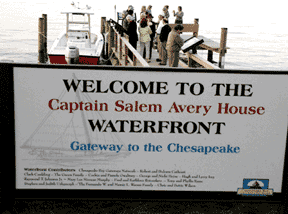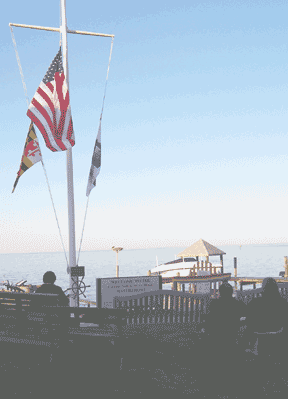 |
|||||||||||
|
|||||||||||
|
|||||||||||
A New Gateway to the BayHistory and community come together at Shady Sideby Ben Miller
Dedicating a new dock at the Captain Salem Avery House and Museum was a big deal for the Shady Side Rural Heritage Society. This waterfront improvement is the latest in a long series of achievements by the small Society. All Bay lovers can celebrate, as well. In an area where miles of Bay shoreline are off limits, this dock and the improved waterfront are open to all. From the dock and benches above, you look out onto the West and Rhode rivers and Chesapeake Bay. You can see the Bay Bridge and the Thomas Point Shoal Lighthouse, read about Bay critters and the waterfront’s history on exhibit panels, pull up the cage of oysters to check how they’re growing, tie up your boat, launch your kayak to explore the rivers and nearby Parrish Creek — and have a picnic. You are welcome every day dawn to dusk. Many Pairs of ScissorsAt the ribbon-cutting to open the new dock, there was a bucketful of scissors — all needed — for all the people who gave time, effort and cold cash. As with many Society projects, this pier was begun with grant money. “The project would not have been possible without the financial help and advice of the Chesapeake Bay Gateways Network,” said President June Hall. This National Park Service Network based in Eastport has brought together 156 public and private parks, museums and wildlife refuges throughout Chesapeake Bay’s watershed from New York to Virginia. The goal of the Gateways is to support “access to and interpretation of Chesapeake Bay,” said Gateway’s Rod Torrez, who wielded one pair scissors. For supplying the “motivation energy” and for being the “inspirer of the project,” Hall credited Society director Janet Surrett, who held another scissors. “The energies came together,” said Surrett, based on a vision to have the waterfront “open and available to the public.”
Contributing to CommunityGetting the job done is routine for the Shady Side Rural Heritage Society, a self-replenishing community of some 400 people from Shady Side and Southern Anne Arundel County, many in their vigorous post-retirement years. People with community roots — now living as far away as California and Belgium — send money back. Since its beginning in 1984, a constant goal of the Society is to celebrate and honor the history and heritage of Southern Anne Arundel County. Another goal, according to vice-president and Society stalwart Mavis Daly, is to contribute to community cohesiveness. The Society has done both. In 1989, the members acquired the Captain Salem Avery House in Shady Side and restored it to its 1860 appearance. In the house and its addition, they established a museum, an archive, a library and a hall for gatherings. Outdoor attractions include two restored historic boats, the racing sailboat Vanity (see www.bayweekly.com/1993/93i12.html) and the workboat Edna Florence (see www.bayweekly.com/1993/93i12.html). Daly remembers her mentor, Ethel Andrews, born November 13, 1888, and knows how happy Miss Ethel would be that the history of Shady Side will be preserved and appreciated for generations to come. “The dream of a handful of people back in 1984 to preserve our heritage has far exceeded anything they envisioned,” said Daly. The Society is “creating a community,” said Hall. She tells people that membership in the Society is a way to “get to know people.” It is also “the best act in town.” Hall knows this from personal experience. “I was new to the West River area when I found this jewel at the end of the road,” she said. She joined, met people and found a way to honor her new community. Hall creates the Society, with bridging the gap between people new to the community and longtime residents while helping both embrace the area’s heritage in a changing environment. What Makes a Museum?Historic societies and museums can be known for what they have — their collections and their historic buildings — or for what they do. With its impressive inventory of buildings, the Historic Annapolis Foundation is known for what it preserves, and its events bring people in to appreciate the architectural heritage of Annapolis. With its main building under reconstruction after Hurricane Isabel damage, the Annapolis Maritime Museum has built a reputation for what it does — music concerts, fund-raising events, an Eastport walking tour and a DVD on the Thomas Point Lighthouse — while working to restore the McNasby Oyster House as a museum. The Shady Side Rural Heritage Society has created an inviting place, but their strength is in what they do. The museum is open only on Sunday afternoons, but this dynamic group of people draws the community into history all year long. It’s thoughtful history. Last winter, for example, speakers at their acclaimed winter luncheon series discussed topics as diverse as a woman’s life on Smith Island, nature photography adventures on the Bay, the Chesapeake voyages of John Smith and the history of chocolate. Performers sang sea shanties. First-person historians gave voice to an enslaved woman who lived to be 99 years old. AheadThis summer and fall, the Society has a slate of events combining history, fun and fundraising. The next event is the Civil War Living History Weekend. Uniformed Union and Confederate soldiers arrive to set up camp on Saturday May 5. On Sunday May 6, they invite children to be “soldiers for a day” to sing songs, cook salt pork, eat hard tack, wear uniforms and drill with wooden muskets. Gilmore’s Light Ensemble plays Civil War period music. The fiercely brave Harriet Tubman, portrayed by Scotti Preston, describes her adventures escaping slavery in Dorchester County and returning many times to rescue her people. (Donation: $3 each or $10 family). Stepping into a New EraFrom the 1920s until 1989, when the Captain Salem Avery home came to the Society, the building was owned by the National Masonic Fishing and Country Club. This group of Masons from Washington, D.C., most of whom were Jewish, purchased the house and land for a recreational community when Jews were denied access to many beach communities. The families spent weekends and summers at what they called Our Place. “I’m almost 82 now,” Florence Schenker was quoted as saying in the Society’s newsletter. “I was going down there when I was in diapers. It was a very family kind of place. … You felt like you were related.” The Society is documenting and interpreting this part of Shady Side history with guest curator Barry Kessler, a former curator of the Baltimore City Life Museums and the Jewish Museum of Maryland, leading and coordinating the project, which goes on exhibit in 2008. A prestigious National Endowment for the Humanities challenge grant and community donations support this and other projects. The Society has also won grants from the Arts Council of Anne Arundel County, the Four Rivers Heritage Area, the Maryland Historical Trust, the Institute of Museum and Library Services and the Maryland Humanities Council, as well as the Chesapeake Bay Gateways Network. This ability to garner a variety of grants is a sign of a solidly based and well-organized historical society. In recognition of the “strong history program and museum,” the Four Rivers Heritage Area honored Surrett with one of its two 2006 Heritage Professional awards. Thankful as Surrett was for the award, she doesn’t take credit for all she and the Society have accomplished. It’s this “incredible group I work with,” she said. “These guys make me look really great.” “I believe in the place,” said Surrett, who became the society’s director in June, 2001, “Nothing is done single handedly.” The Society will say goodbye to Surrett this summer when she resigns to move with her husband Roy to Great Britain for several years. The Society is taking applications for this part-time position (or as Surrett says, “flexible full-time.” Visit www.averyhouse.org for a job description).
A Place for PeopleAs Hall experienced and Surrett confirms, the strength of the Shady Side Rural Heritage Society is not the artifacts, the house, the programs or the projects. Strength is its people. By joining to preserve the area’s history, heritage and culture, the Society is creating its own culture and community. It is helping bring people together, both natives and newcomers. Traditionally, communities in Southern Anne Arundel County gathered around tobacco wharves and warehouses, markets, schools and churches and post offices. Now development changes the character of the area without creating communities. Take part in any of the many events of the Shady Side Rural Heritage Society, and it’s a good bet you’ll have a good time and meet some good people. That’s how communities are made, and you’ll be thankful you came. Captain Salem Avery House Museum, 1418 EW Shady Side Rd: 410-867-4486; www.averyhouse.org. Ben Miller, Bay Weekly’s museum reviewer, took home a first place Maryland, Delaware, D.C. Press Association prize for his April 27, 2006, story Learning From Where They Live: At Chesapeake Bay Earth School, Chesapeake Bay — and Bay Weekly — Are Textbooks. |
|||||||||||
|
|||||||||||
|
|
|||||||||||
|
© COPYRIGHT 2007 by New Bay Enterprises, Inc. All rights reserved. |
|||||||||||


